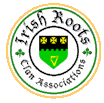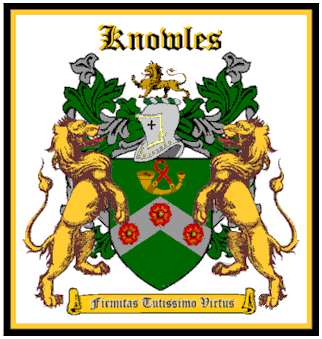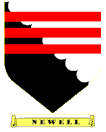Knowles Coat of Arms from Ireland and England.
|
|
|
|
|
Crest: A lion passant or. A gold lion, walking. The lion represents strength and valour. Motto: Firmitas-Tutissimo-Virtus:
"From valour comes strength and protection." The establishment of Coats of Arms was introduced into Ireland by the Normans in the eleventh century and was adopted by some Gaelic families. These armorial bearings originated during the late medieval period as a means of recognition on the battlefield. Their use gradually became the badge of identity for a family and were used in documents as personal seals and to identify property. A coat of arms is strictly hereditary within a single family in English and Scottish heraldry. The crest and shield were granted to one individual not to everyone with the same surname. In Ireland, the shield was often regarded as the property of the tribal sept. |
| War of the Roses (1450-1485)
The House of York was represented by the white rose and the House of Lancaster by the red rose. These two powerful English families battled to determine who would rule. Henry IV (1399-1413) was the first Lancaster king after his defeat of Richard II. After years of conflict, Edward IV (1461-1483), became the first York king. After the death of Edward, Richard of Gloucester became Richard III. Richard was defeated at Bosworth Field in 1485 and Henry VII became the first Tudor king. Henry VII was a Lancaster by blood and a York by marriage. Many of the Knowles family in England supported the Lancaster (red rose) family. War of Roses and Ireland One of the great Norman Families to settle in Kildare were the Fitzgeralds. John Fitzthomas, Lord of Offaly, who was created Earl of Kildare in 1316, received a grant of land and established Maynooth as a family seat. Garret Mor the Eighth Earl was a Yorkist supporter, and, following the victory of the Lancastrians in the War of the Roses, he supported the claims of the Pretenders to the English throne, Lambert Simnel and Perkin Warbeck. The O'Tnuthghail and other smaller septs of Kildare supported the Lancaster or red rose family. The coat of arms in Ireland and most of the English coats display three red roses on a silver or white chevron. |
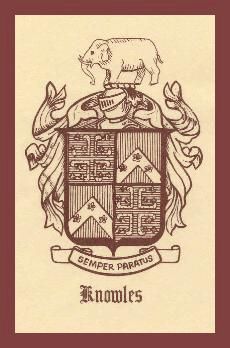
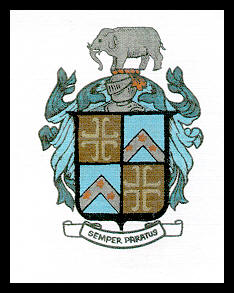
|
Coat of Arms from Rietstap Armorial General. Translation for shield: Shield
divided into quarters (a la croix) Charge placed over four
quarters (sur le tout). Croix = cross, azure = blue, chev =
chevron, seme = borders, champ = field, d'or = color gold, nillee
= cross divided, meme = corded cross, Motto: Semper Paratus = Always Prepared |
|
Several coat of arms are listed for the Knowles surname. The General Armory lists:
|
|
|
|
|
|
Aylesham co. Norfolk. Gu. on a chev. ar. three roses of the field, in chief a crescent or. charged with a mullet sa. Crest: A rams head ar. attired or. The crescent indicates the Crusades and was introduced by the crusaders during the reign of Henry III (1216-1272). |
|
|
Cross
Moline Voided. The term as applied to the cross occurs twice in one of the two rolls which are apparently of HENRY III 's reign. Also in a roll temp. EDWARD II. two examples occur with the term voided added and one without, though in the latter voided is, no doubt, implied; hence, as the general outline was similar to the cross moline, it may be considered as a cross moline voided, or disjoined, and drawn as in arms of KNOWLES. source: A Glossary of Terms Used in Heraldry by James Parker 1894 |
|
|
|
Newell: Ref: B730/03 Newell (no further family information recorded) Arms: Argent three bars Gules over all a bend engrailed Sable. Crest: None recorded. Motto: None recorded. |

